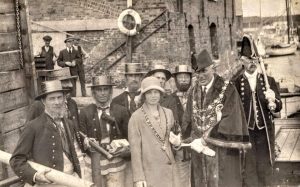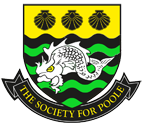 The original purpose of the Beating of the Bounds of Poole Harbour was to check the various marks and boundaries of the original Winchelsea Certificate, awarded to Poole in 1364, to see that the “bounds” or boundary markers still exist, that they are in the correct position and that there has been no encroachment upon waters belonging to the Port of Poole.
The original purpose of the Beating of the Bounds of Poole Harbour was to check the various marks and boundaries of the original Winchelsea Certificate, awarded to Poole in 1364, to see that the “bounds” or boundary markers still exist, that they are in the correct position and that there has been no encroachment upon waters belonging to the Port of Poole.
The Winchelsea Certificate was of prime important to Poole as it confirmed the limits of the town’s maritime jurisdiction over the port. The Mayor being “admiral of the Port” it was he who presided over the locally held Admiralty Courts and it was essential to know his jurisdiction.

Wareham was a particularly difficult neighbour with their fishermen accused in 1600 of driving all the fish out of the harbour. They were finned ten shillings! Although many of the boundary points were well known they weren’t all properly defined, however from approximately 1612 one boundary was deemed to commence at “Brome Hill” (now Broomhill in New Quay Road, Hamworthy) thence to “Shag Rock” above Russel Point “right against a little hill called Redcliffe Atwell” in the Wareham Channel some 3 miles from Poole. Indeed, various methods have been used to define the boundaries including in 1609 an Admiralty Court in Poole held that the “liberties, franchises and privileges of Poole extend from “the North Hauen Poynte as farr to seaward as a Humber barrelll maie be seene and described in the sea” which is about 3 miles from shore.
In 1661 it was recorded that an event to “beat the bounds” was done for enjoyment and public participation. Some 20 boats set out with drums beating and colours flying, and the town was saluted with a gun “The good company made merry with the good liquors and provisions they carried with them for that purpose”. In 1778 ha’penny pieces were for the first time thrown by the Mayor to children and music started to be played with two bands accompanying the party recorded in 1834.

The event was growing, in 1821 several thousand were noted to be assembled at North Haven and a 21-gun salute fired from Brownsea Island. Indeed, the Council proved dinner for 500 people and a fireworks display was seen at Heckford Field lasting until midnight. Unfortunately, the ceremony lapsed in 1834 but was revived in 1921 as a consequence of legal action taken against local residents for trespass on parts of the Harbour Shores.
Since 1921 the ceremony has been undertaken many times with hundreds of boats escorting the Mayor and with parties and entertainment provided. In 1961 the ceremony was joined by the Jolly Pirates of Poole who added spice and fun to the event whilst collecting for the Mayor of Poole’s Charities. The Society for Poole, which was then The Society of Poole Men, played a pivotal role in all ceremonies since 1924 by providing Jurors escorting the Mayor on his journey across the waters of the Harbour but also supporting each Mayor on every Organising Committee.
The Society for Poole aims to re-establish the event on Poole’s event calendar, restoring this ancient ceremony, unique to Poole, by creating the pageant, a spectacular and fun event with sea shanty music and stalls along the Quay as well as Pirate “fights” and the Jurors parade.


